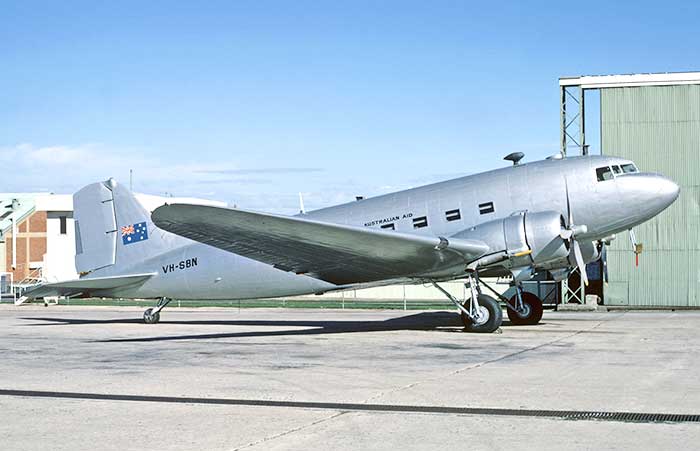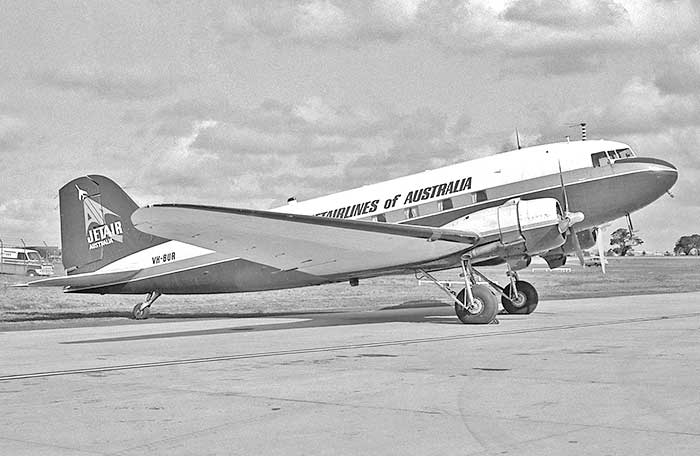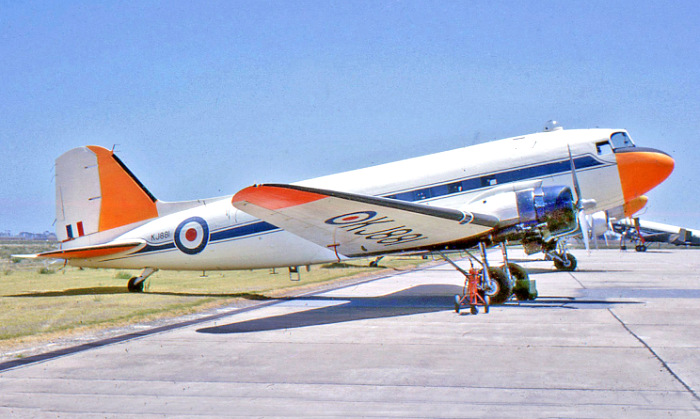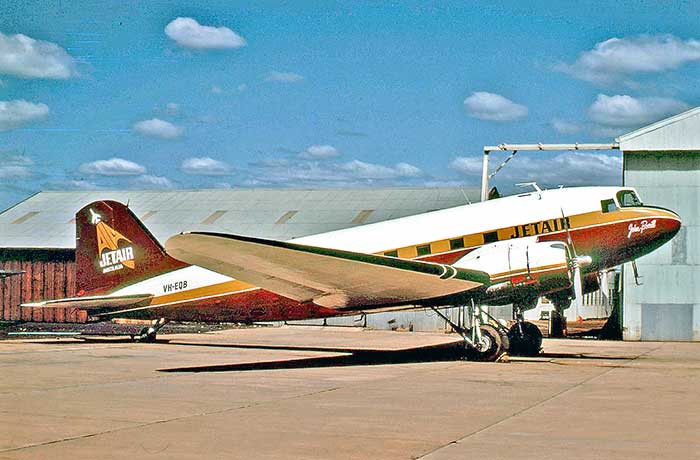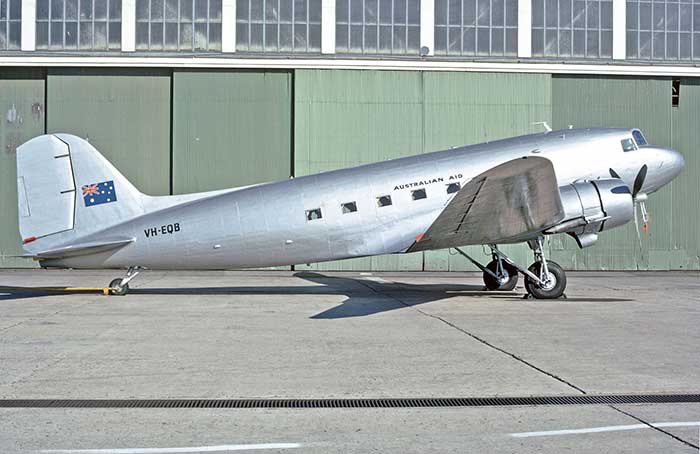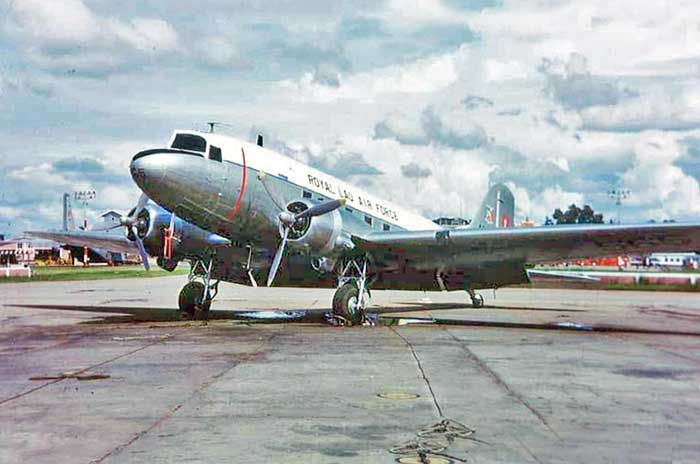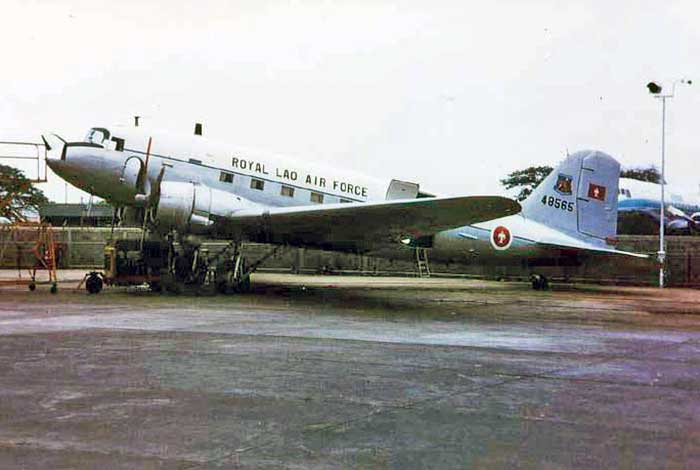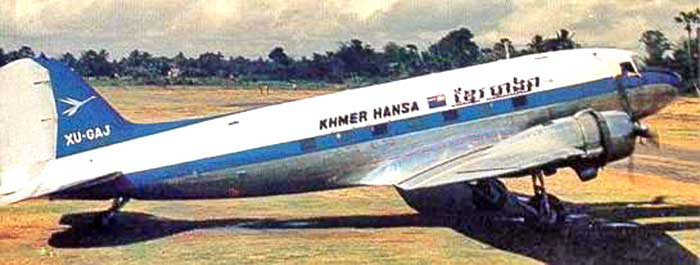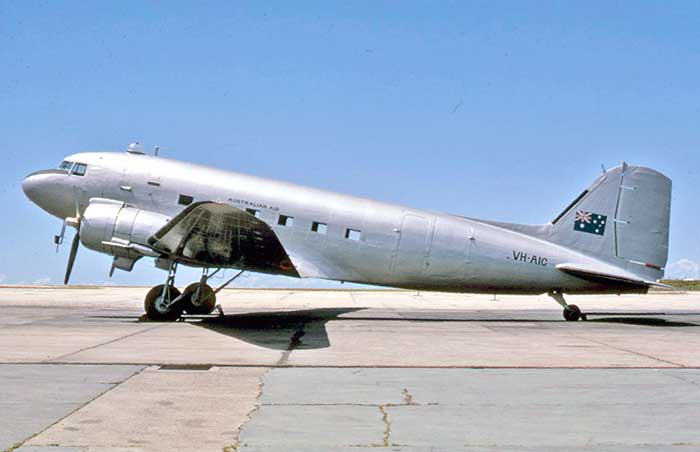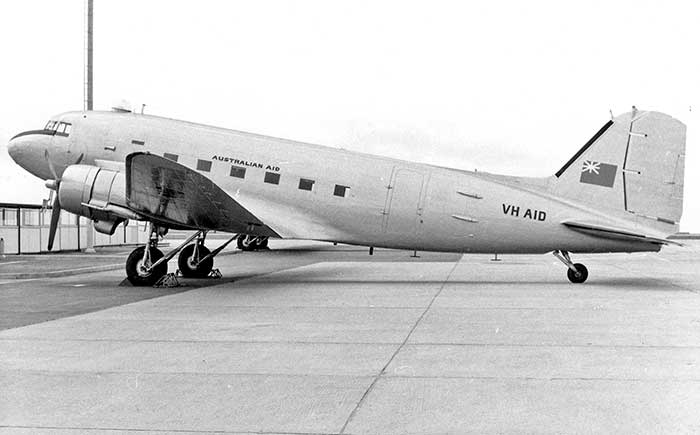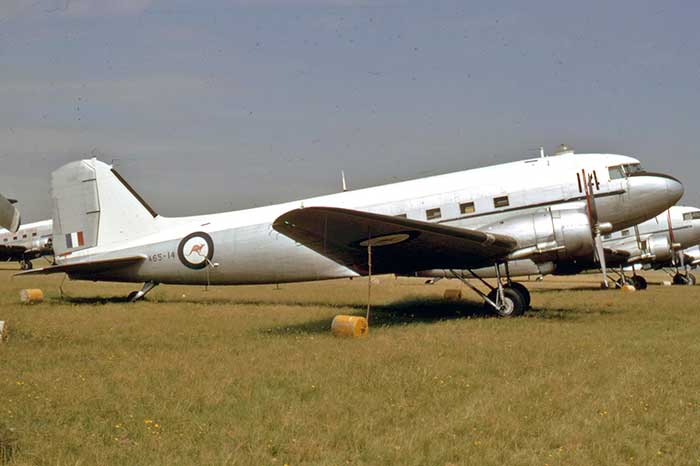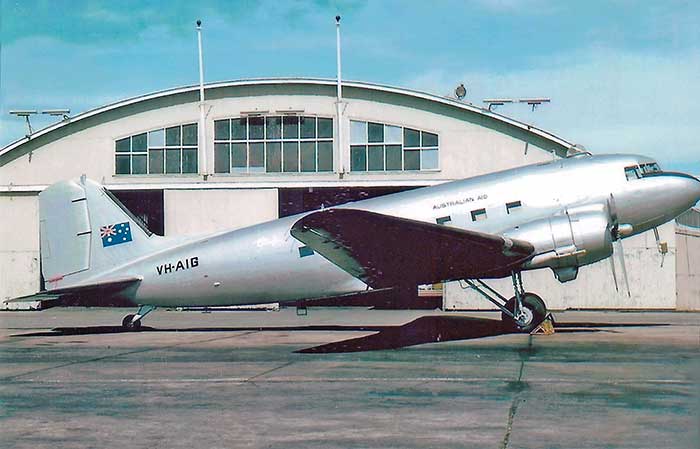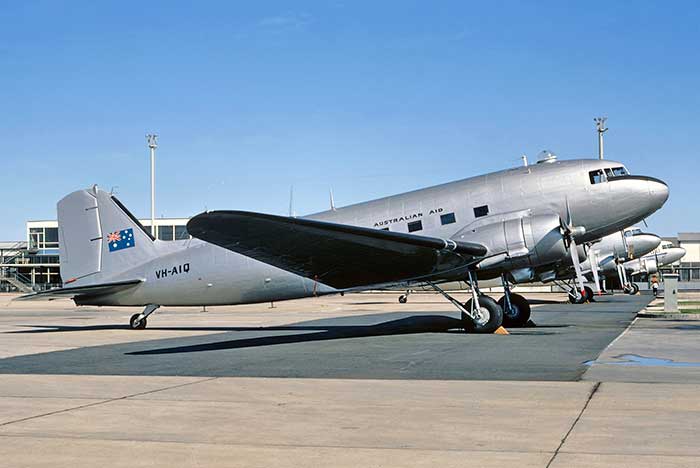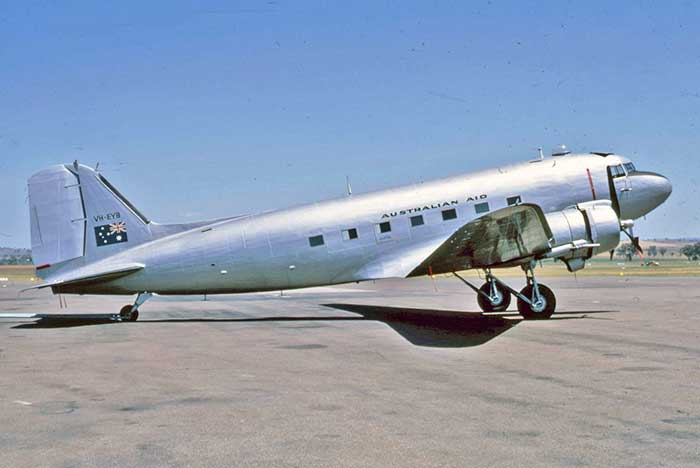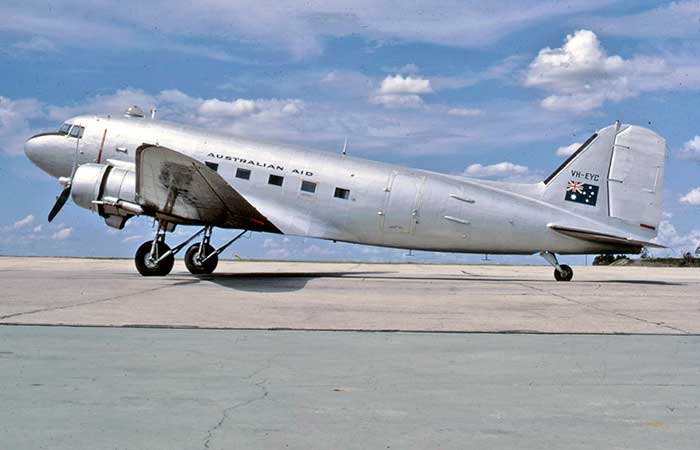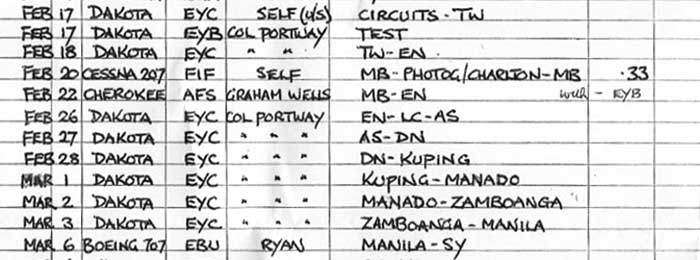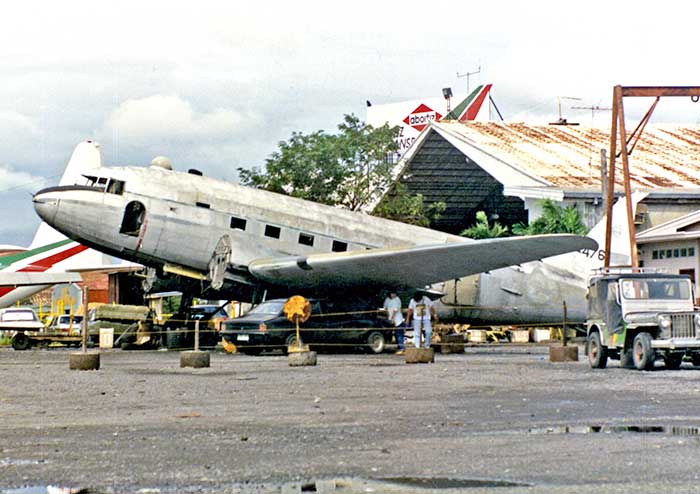Compiled by Geoff Goodall
various South East Asian countries. These deliveries took place at the same time as the airliner sales listed in Parts 1 & 2:
THE PARAFIELD SEVEN - STANLEY L. BOOKER
In May 1968 tenders were officially called for the disposal of 7
retired RAAF Dakotas at Parafield Airport, Adelaide SA. However the
disposal had been planned for over a year, as the Dakotas were ferried
to the military overhaul hangars at Parafield, which were still
referred to as the "DAP hangars", from their wartime use by the
Departrment of Aircraft Production.
During 1967 American aircraft salesman Stanley Booker visited Adelaide several times. He had a ferry contract to deliver new Cessna 310s and 402s to the Indonesian Air Force (AURI), and after each delivery would look for aircraft sales opportunities in neighbouring countries. He had heard of the pending Dakota disposal at Parafield and visited for talks with disposals officials and inspect the aircraft. While at Parafield he met the local team planning to recover the six atomic test Mustangs at Emu in the SA desert. Stan quickly struck a deal whereby he would finance their purchase and recovery costs, in return for the Adelaide group retaining the best aircraft for themselves.
He arranged to have his five Mustangs shipped from Parafield to a warbird dealer in New York, and the sixth Mustang A68-1 was also included at the last moment when the Adelaide group signed it over to Booker after the Department of Civil Aviation refused to allow it to be civil registered. (See EMU ATOMIC MUSTANGS in the Photographs section of this site)
In June 1968 Booker won the tender process for the 7 Dakotas, under the name CalgAir Sales Inc, Calgary, Canada: the former RAAF A65-60, A65-70, A65-85, A65-101, A65-117, A65-118 and A65-119.
During 1967 American aircraft salesman Stanley Booker visited Adelaide several times. He had a ferry contract to deliver new Cessna 310s and 402s to the Indonesian Air Force (AURI), and after each delivery would look for aircraft sales opportunities in neighbouring countries. He had heard of the pending Dakota disposal at Parafield and visited for talks with disposals officials and inspect the aircraft. While at Parafield he met the local team planning to recover the six atomic test Mustangs at Emu in the SA desert. Stan quickly struck a deal whereby he would finance their purchase and recovery costs, in return for the Adelaide group retaining the best aircraft for themselves.
He arranged to have his five Mustangs shipped from Parafield to a warbird dealer in New York, and the sixth Mustang A68-1 was also included at the last moment when the Adelaide group signed it over to Booker after the Department of Civil Aviation refused to allow it to be civil registered. (See EMU ATOMIC MUSTANGS in the Photographs section of this site)
In June 1968 Booker won the tender process for the 7 Dakotas, under the name CalgAir Sales Inc, Calgary, Canada: the former RAAF A65-60, A65-70, A65-85, A65-101, A65-117, A65-118 and A65-119.
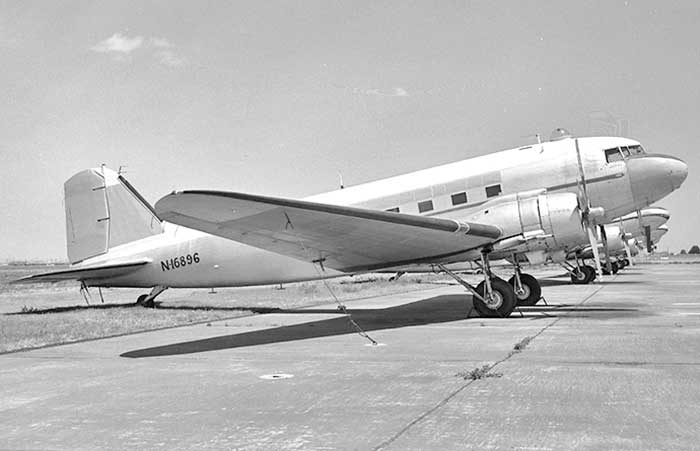
ex-RAAF Dakotas at Adelaide's Parafield Airport in 1968. Photo by Geoff Goodall
- Stan's Airplane Sales Inc, Fresno, California
- Stan Air Inc, Fresno California
- Stanair Corp, Calgary, Aberta, Canada
- Calgair Inc, Calgary, Alberta
- CalgAir Sales Inc, Calgary, Alberta
But by September 1968 Stan Booker had seven C-47s and no customers. His soon came up with answer: set up his own airline in Indonesia, where aviation licencing rules hd been relaxed to allowing new-start local airlines.
With his Indonesian experience, he soon found fellow American entrepreneurs prepared to join him and a new airline Sempati Air Transport at Jakarta. It commenced in March 1969 flying charter with the RAAF C-47s registered as DC-3s PK-JDA to PK-JDG. Within a year or so, Stan was involved with another new airline Trans Nusantara Airways and shared the ex-RAAF DC-3s as well as personally delivering several US corporate DC-3s to Indonesia for them. Soon management of Sempati Air Transport had changed and Stan Booker had vanished. His previous American colleagues made enquiries in Australia and USA seeking his whereabouts, but by then Stan was in Laos, running different DC-3s on lucrative US Aid contracts.
The seven C-47B RAAF Dakotas sold to Stan Booker in June 1968:
Departed Parafield 4.8.69 as N16892 on delivery to Indonesia. US Civil Register added N16892 15.8.68 to Stan Air Inc, Fresno CA.
On arrival Indonesia it was registered PK-JDE 1.8.69 to Safari Air, Jakarta.
Reregistered PK-EHC 6.7.70 to Trans Musantara Airways/Transna. Crashed 19.1.73 landing at Pontianak, Borneo, destroyed by fire.
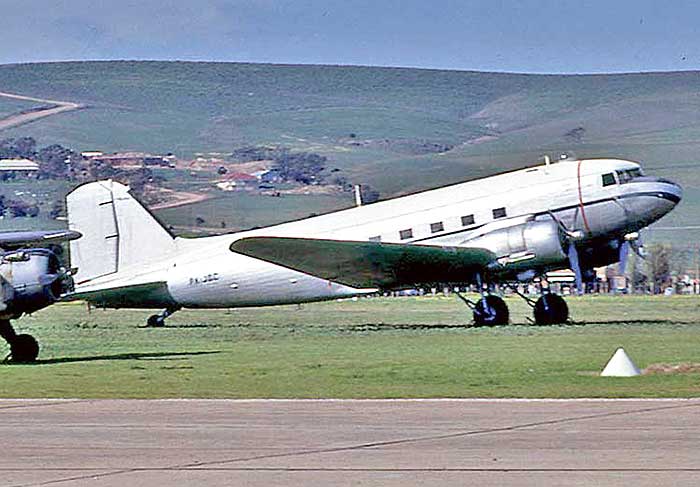
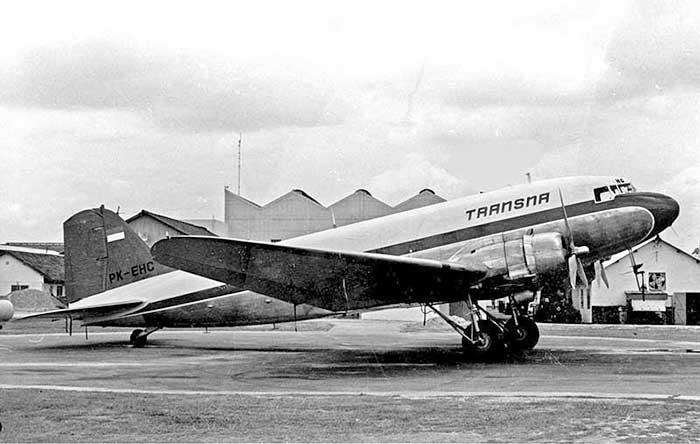
Between at least 1977-1981 leased to Zamrud Aviation at Denpasar, Bali. Fate unknown.
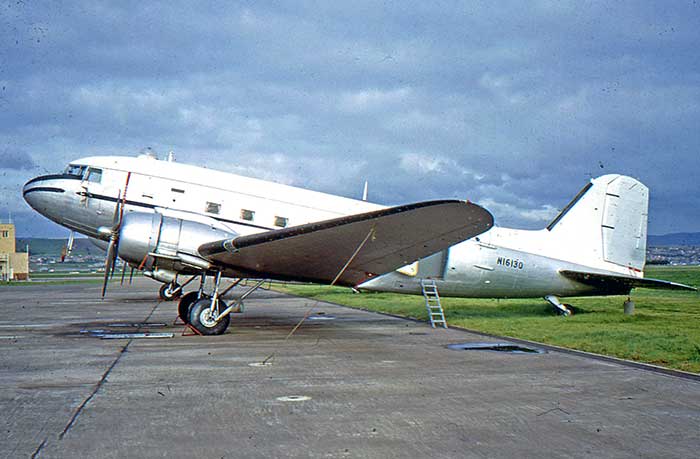
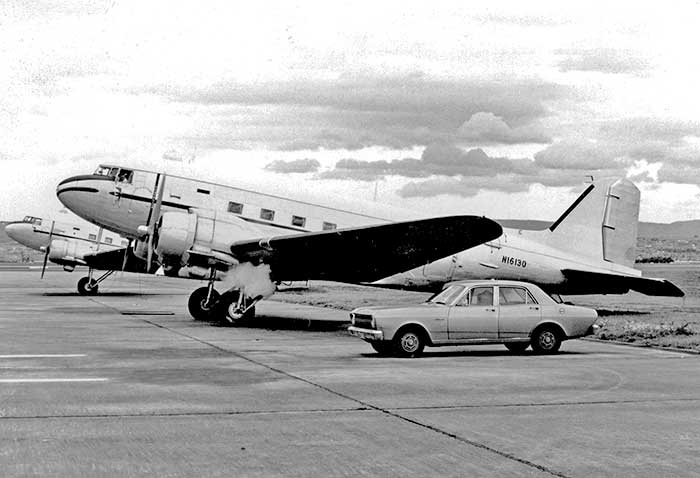
Photo by Mike Vicent
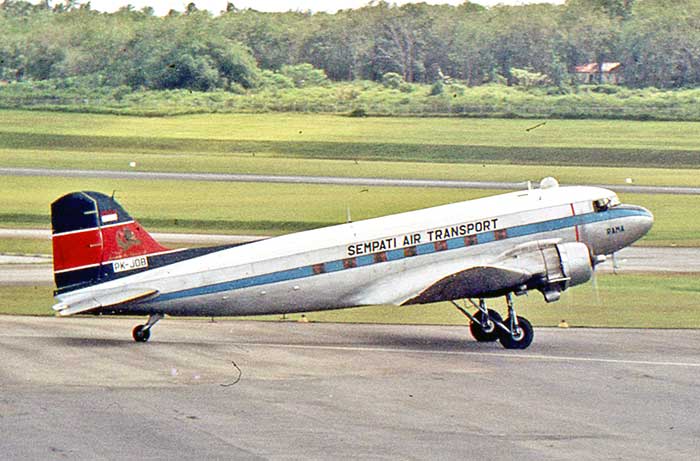
Some interesting emblem has been painted over on the tail. Photo: Nigel Daw collection
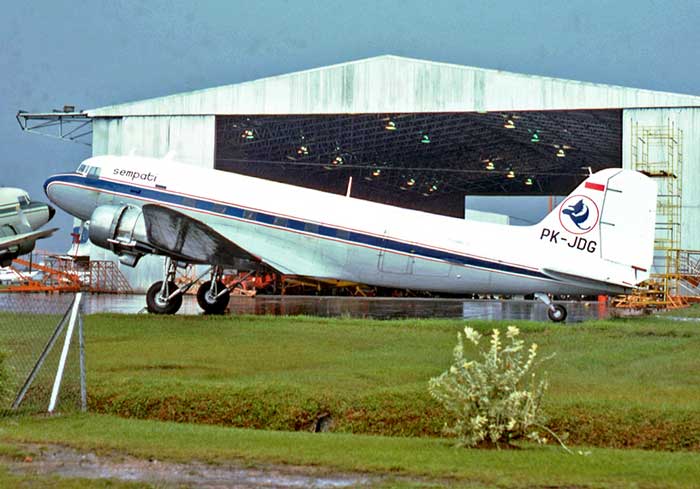
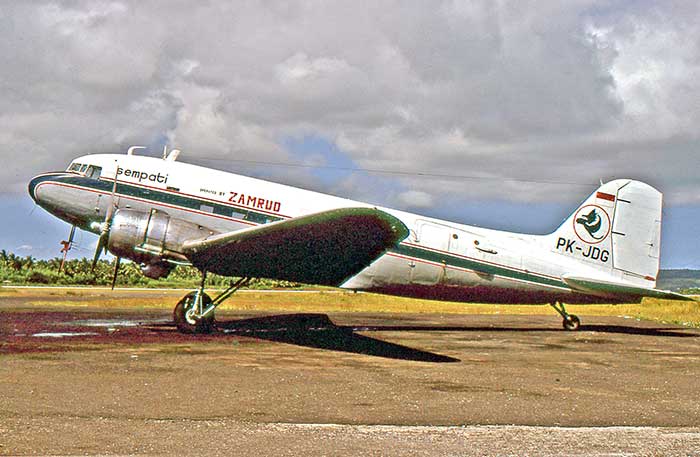
Painted as PK-JDD 6.69. Stan Booker commenced test flights on 19.7.69 with circuits at Parafield and then Adelaide-West Beach Airport, remained parked at Adelaide Airport until 22.7.69 when Stan Booker arrived from Parafield in N16895. N16895 was left at Adelaide while Stan flew PK-JDD to Parafield. Returned to West Beach from Parafield 21.7 and overnighted, returned to Parafield 22.7.69. Repainted at Parafield as N16893 and departed Parafield 27.7.69 on the ferry to Indonesia, flown by Stan Booker and his partner Don Reidpath, carrying 2 Indonesian pilots and an Indonesian CAA examiner. Landed at Leigh Creek SA, Alice Springs, Darwin, generating a number of SAR Phases due lack of radio contact. DCA incident report quotes "Captain of N16893 is already under the scrutiny of the Inspector of Air Safety due to his irregular departures from Parafield."
On arrival Indonesia, reverted to PK-JDD, officially registered as such 18.6.69 to Sempati Air Transport. Did not enter service with Sempati. Parked at Jakarta-Kemayoran, where it was still sitting in 11.70, weathered condition with both registrations readable.
Cancelled from Indonesian Reguister 12.70.
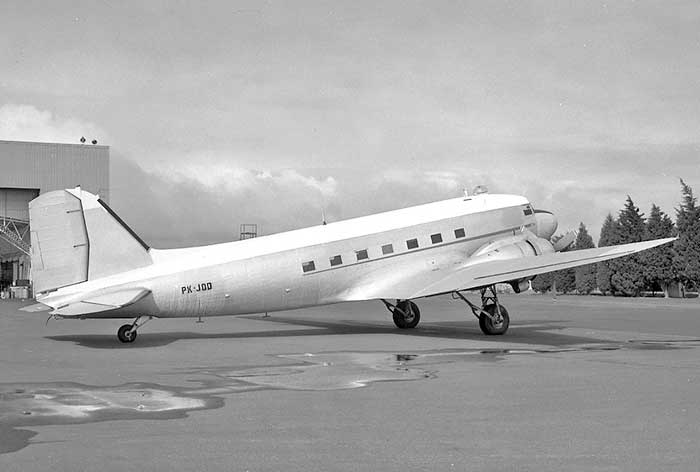
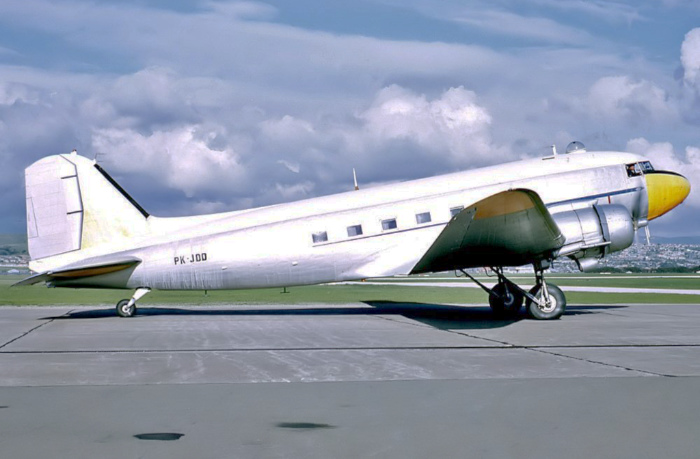
PK-JDD taxying at Parafield for a test flight in July 1969. David Anderson collection
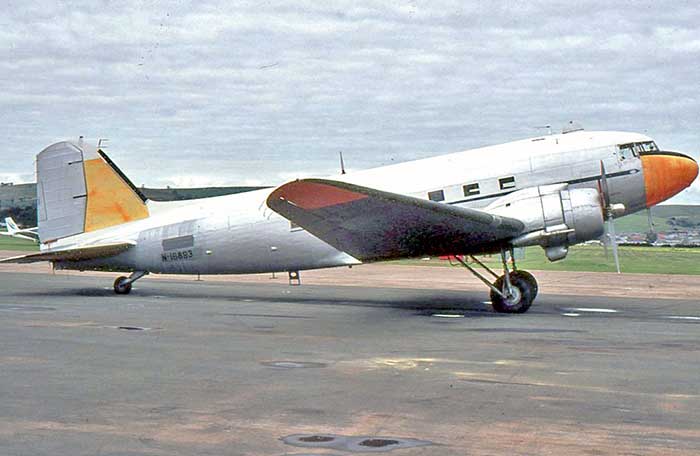
Photo by Nigel K. Daw
Painted as N16894 7.68 a few days before it departed on delivery to Indonesia. Registered PK-JDA 28.5.69 to Sempati Air Transport.
Reregistered PK-EHD during 1970 to Trans Nusantara Airways/Transna. Retired at Jakarta-Kemorayan by 1973.
Sold to Weyerhaeuser Philippines Inc, Manila.N16895 painted on aircraft at Parafield 18.7.69. Flew pilot training circuits at Parafield 20.7.69, Stan Booker flew N16895 to Adelaide Airport 22.7.69 where it was parked overnight. Departed Adelaide Airport 6.30am next morning 23.7.69 for Alice Springs as first stop on delivery to Philippines, under command of Captain Leonardo L. Flores, chief pilot of Weyerhaeuser Philippines Inc. This was the Filipino associate of large US timber company Weyerhaeuser International Inc.
Registration PI-C1937 had been allocated 23.7.69 but was not taken up. Remained as N16895 to Weyerhaeuser Philippines Inc.
N16895 was noted at Singapore-Seletar 27.6.71, but was cancelled from the US Civil Register by 1.72. Fate unknown.
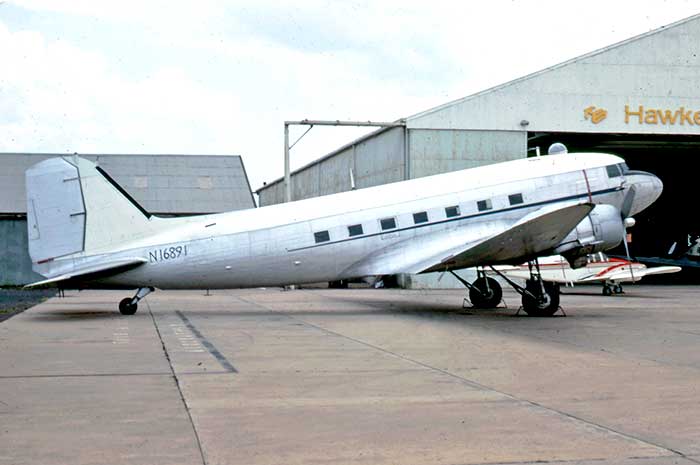
Photo by Roger McDonald
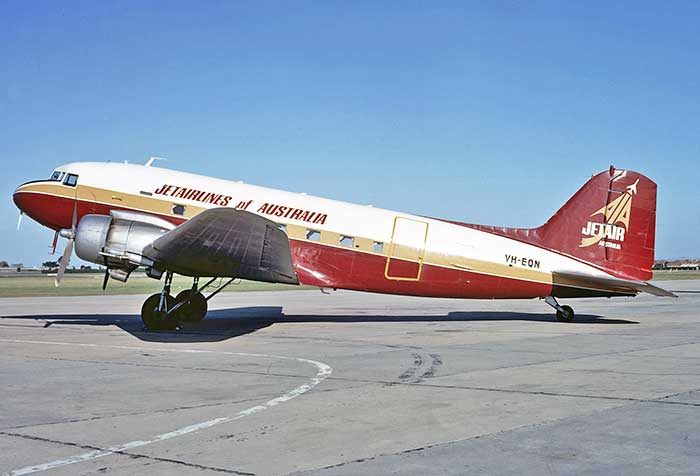
Photo by Barrie Colledge
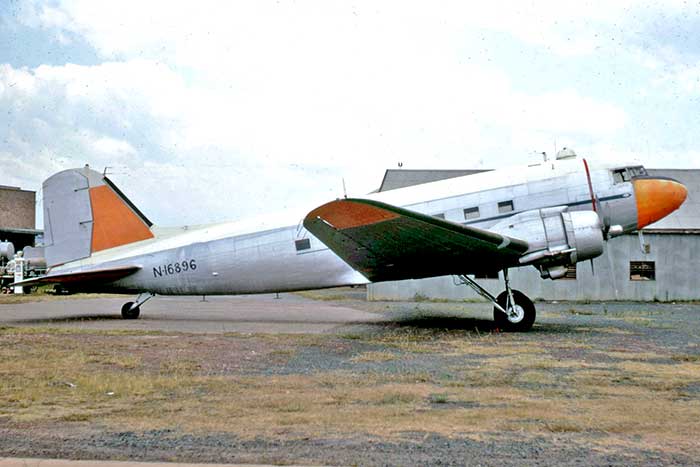
Photo by Roger McDonald
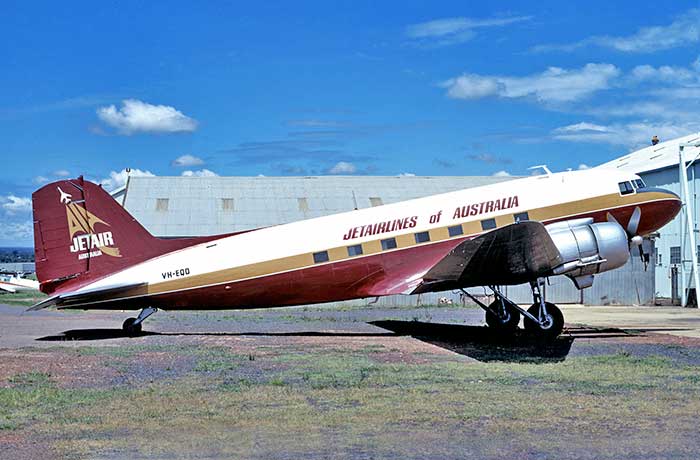
Photo by Barrie Colledge
Interestingly a Beech D18S N445EA owned by Stan Air Inc, Fresno California was damaged by an undercarriage collapse while landing at Albuquerque NM 27 June 1970 on delivery to new owner Westernair of Albuquerque.
Later in 1970 Stan Booker was based in Singapore reselling American DC-3s to SE Asian buyers. For a time he and his family lived in a US corporate DC-3 he had ferried from USA and parked at Singapore-Seletar, making use of the luxurious "air yacht" cabin. Learning of demand for DC-3s in Laos and Cambodia with a variety of obscure local operators carrying US Aid supplies in these impoverished countries with their own civil wars. Vietnam War politics had resulted in civil contractors being paid to do the work usually handled by the CIA's Air America Inc. Booker began operating DC-3s himself in those countries, flying dubious "hard rice" cargo and local passengers, some clutching live pigs in their laps. He employed American pilots on tight contracts. who set up their Pig Pilots of Phnom Penh association. Booker became a key player in the humanitarian airlift when roads into Phnom Penh were cut, his pilots flew into Phnom Penh under shelling and rocket attacks from the saurrounding Khmer Rouge.
Booker left Laos by the end of the civil war in 1975, returned to USA and bought into a charter company Nevada Airlines as Las Vegas, Nevada. Nevada Airlines specialised in tourist flights to the Grand Canyon, mostly with trigear Beech 18s. With plans for expansion into larger aircraft a Martin 404 N40438 was acquired but crashed at Grand Canyon Airport in November 1979, killing all 44 on board. Nevada Airlines was shut down by the FAA because of serious operational irregularities found during the investigation.
Booker moved to Florida where he became involved in the then booming drug running trade. The US Drug Enforcement Agency hAD BOOKER UNDR SURVEILLABNE special agent was later quoted "Booker was one of the foremost drug smugglers we are aware of in this country. He’s known to have brought in planeloads of marijuana from Mexico. We seized two of them coming into the southwest from there but he wasn’t aboard. The DEA has documentation that Booker had owned over 200 airplanes"
Stanley Louis Booker was killed on 16 March 1984 in his high-performance Lockheed 18 Learstar, which he had also changed to his favourite registration N77777. The aircraft crashed in a forest on approach to land at Oneonta, NewYork at night in low cloud and fog, no Flight Plan submitted. Booker and his copilot were killed. Found in the wreckage were 35 bales of marajuana weighing 3,500 pounds.
DC-3s gifted to other countries - whether wanted or not
The Directors were anxious to achieve the best prices for the sale of Jetair assets, mainly the aircraft.
Early in 1971, the Federal Government announced a major humanitarian initiative to assist the people in the countries involved in the South East Asian war zone, despite the official denial of any US military participation in Cambodia and Laos, where there were civil wars. Australia woud donate transport aircraft to countries whose embassies have requested Australian assistance.
Douglas C-47s were allegedly wanted by these countries, and the Department of Foreign Affairs quickly purchased the retired fleet of Jetair DC-3s, parked at Sydney Airport, at prices later claimed in Parliament to be well above going rates. RAAF Dakotas were released to the Department of Foreign Affairs, which sought tenders for their overhaul to civil Certificate of Airworthiness standards, despite most being destined to go to foreign air forces. East West Airlines at Tamworth NSW and Forrester Stephen Aviation at Melbourne-Essendon won the tenders to carry out the overhauls and once again, subsequent Parliamentary debates revealed the cost was well above normal commercial rates. The 13 collected aircraft, now all designated DC-3s, rather than the requested military C-47s, were now ready for delivery.
It was around this time that the destinations of the DC-3s were announced, under the auspices of Australian Aid:
Laos Air Force (3), Cambodian Air Force (6), Philippine Air Force (2), Royal Nepal Airways (2)
They were all delivered by Australian civil pilots on contracts towards the end of 1971.
Subsequent Parliamentary debate revealed that Cambodia had never requested any aircraft, and questioned the personal friendship between the then Prime Minister and one of the founders of Jetair Australia. The inference was that Australian Aid DC-3 gift program was at least in original concept, a means to realise a good sales price for the entire Jetair DC-3 fleet, rather than individual sales in the commercial market place. Other questions remain:
- were the founders of Jetair given some indication that the current Government would assist their new-start airline, which was defying the Government's own Two Airline Policy? The Jetair Directors seemed optimistic despite any business model showing that the heavy costs of purchasing and converting aircraft which would fly only low-yield country services doomed their airline to fail.
- The Department of Administrative Services advertisements for the RAAF Dakotas and RAAF Bristol Freighters acquired by Jetair stressed these aircraft must be exported or scrapped. The sale contract documents carried the same restriction, stating that these aircraft could not be re-sold or flown within Australia. It was a DCA requirement to protect the Government's Two Airline Policy by preventing these aircraft being acquired by a new-start airline. Yet that is exactly what happened with Jetair, when they confidently breached the sales contract by purchasing these ex RAAF aircraft and converting them to civil standard.
- Why were Australian transport aircraft gifted to Cambodia and Philippines, both large scale recepients of aircraft from US Government in return for allowing their territory to be used by the US military during the SE Asian war period? The two DC-3s to Nepal went straight to the national airline, hardly humanitarian relief - more likely the Colombo Plan support program.
The first 6 are the Jetair Australia DC-3s. Their histories prior to the Jetair collapse in November 1970, are omitted. All six were parked in a line at Sydney Airport , until collected by the Department of Foreign Affairs for the Australia Aid project.
To Royal Lao Air Force as 998. (c/n 9998).
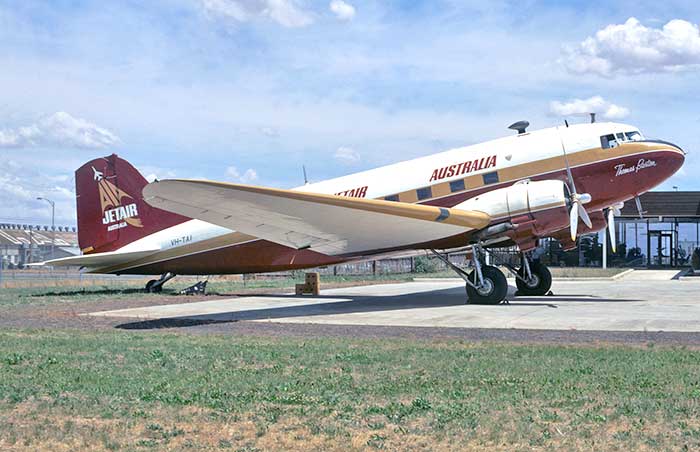
Photo by Barrie Colledge
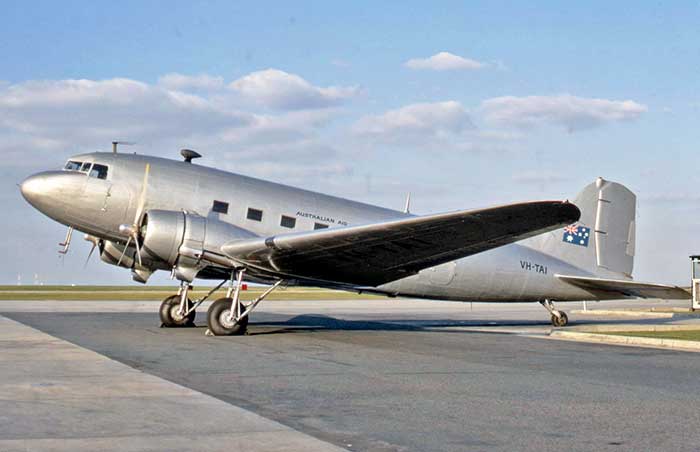
Cancelled Australian Register 6.9.71. To Cambodian Air Force as 24139 (original USAAF serial 42-24139)
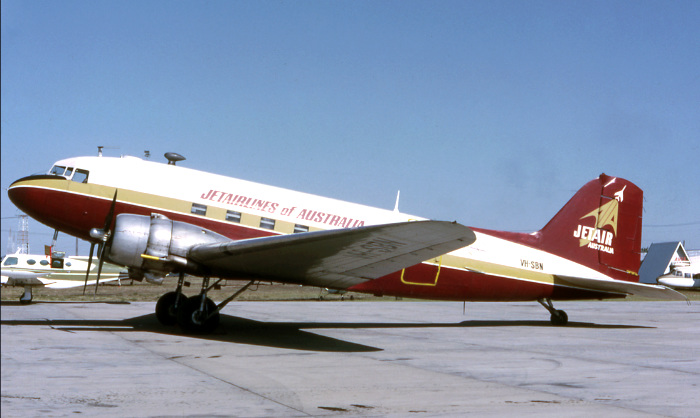
VH-SBN
in Jetair service at Sydney Airport in October 1970.
Photo by David Carter
